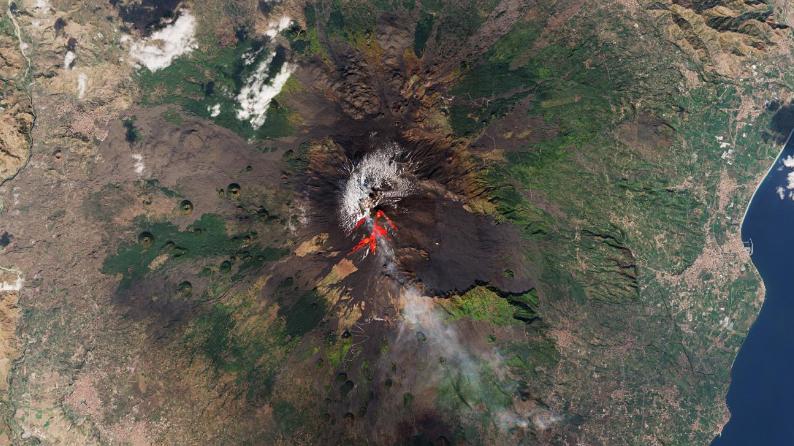
On Sunday (Nov. 12), Sicily’s Mount Etna volcano began belching out lava flows and ash clouds. The next day, the European Space Agency’s Copernicus Sentinel-2 mission captured those lava bursts in infrared.
The European Space Agency’s Sentinel program currently consists of eight satellites, launched between 2014 and 2020. The satellites' eyes are turned down toward Earth, constantly monitoring the planet’s surface. They watch everything from weather and ocean conditions to surface ice and air quality.
Sentinel-2’s specific focus is on studying Earth’s land — forests and farms, for instance — to examine how regions change over time and in response to human activities. Sentinel-2 actually consists of two satellites itself, Sentinel-2A and Sentinel-2B, both of which lie in an orbit that crosses over Earth’s poles. The two satellites are always on opposing points of the world.
Related: Cute lunar robots test their skills on Italy's Etna volcano
By monitoring the volcano in infrared, these two satellites managed to pick up evidence of lava flowing down its slopes. Other observations can discern mudslides, ground fissures, earthquakes, and other ground activity, plus the aerosols in the atmosphere released by the eruption.
Monitoring Etna is important because this eruption was not exactly a "rare" sight. Etna is one of the world’s most active volcanoes, frequently belching out lava and ash clouds from time to time. Plus, the volcano is situated in a populous part of Europe. The city of Catania, in the center of a metro area with more than a million inhabitants, lies at the volcano’s base.
While the present eruption has not threatened the city, others do often disrupt Catania’s airport traffic — hopefully that'll be the worst of it.
Get the Space.com Newsletter
Breaking space news, the latest updates on rocket launches, skywatching events and more!
Join our Space Forums to keep talking space on the latest missions, night sky and more! And if you have a news tip, correction or comment, let us know at: community@space.com.

Rahul Rao is a graduate of New York University's SHERP and a freelance science writer, regularly covering physics, space, and infrastructure. His work has appeared in Gizmodo, Popular Science, Inverse, IEEE Spectrum, and Continuum. He enjoys riding trains for fun, and he has seen every surviving episode of Doctor Who. He holds a masters degree in science writing from New York University's Science, Health and Environmental Reporting Program (SHERP) and earned a bachelors degree from Vanderbilt University, where he studied English and physics.









